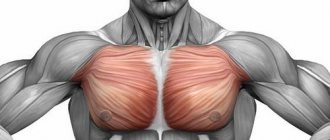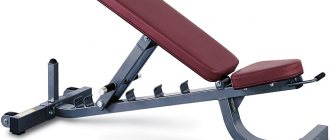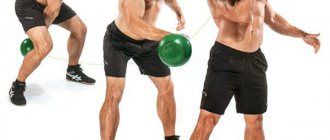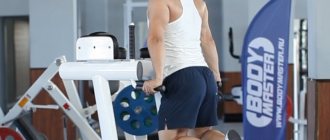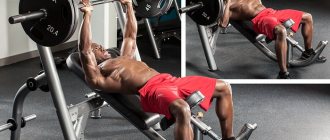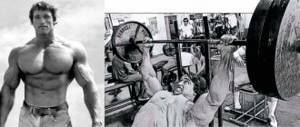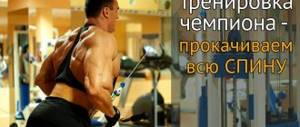Almost every guy dreams of pumped up muscles and broad shoulders and is looking for a way to pump up his pectoral muscles.
In addition, girls cannot resist the chest of a pumped-up man, although they themselves do not mind having trained, elastic shoulder muscles. Because such a standard never goes out of style.
But few people understand that for such an effect it is necessary to make enormous efforts and you cannot do it without visiting the gym. That's for sure!
How to pump up pectoral muscles at home and is it even possible? This is the question most beginners ask, and professionals answer that at home you can only make corrections, maintain shape and give more visual effect. But you can’t do without simulators and an individual training program. As for home exercises, they are universal, but only if additional rules are observed.
How long does it take to pump up the pectoral muscles: effective exercises, technique, photo
- December 18, 2018
- Workouts in the gym
- Nikita Novikov
How long does it take to pump up your pectoral muscles? What are the best exercises for chest training? How to pump up your pectoral muscles at home? Is it possible to pump up your pectoral muscles with push-ups? These questions interest many novice athletes. In the publication you can find answers to your questions. To find out how long it takes to pump up your pectoral muscles, we recommend reading this article to the very end. This way you won’t miss anything important and will receive a lot of useful recommendations.
Quickly pump up your chest
To quickly pump up and show off your results all summer:
- Give up bad habits, including drinking alcohol and tobacco.
- Make a complete diet, both in terms of calories and vitamins.
- Use protein, creatine, BCAA and other special sports nutrition.
- Start doing push-ups, including using weights.
- Gradually progress to dips.
- Exercise with dumbbells, bringing your arms behind your head and jerking the dumbbells above body level. From a lying position, of course.
- Try your hand at the barbell. Do not overestimate your strength during the first approaches; be sure to ask someone to back you up.
If you follow all these recommendations and don’t skip training, the results won’t take long to arrive. Of course, a lot depends on your body type. For some it is easier to achieve results, for others it is more difficult. But in any case, it’s really possible to pump up, the only question is the amount of effort
effort.
Sometimes it is more important to take care of your health than to learn how to quickly build up your pectoral muscles. For an untrained person, sudden loads can have unpleasant consequences.
Anatomy
Exercise and frequency of training is, of course, a very important topic, but first it would not hurt to understand the anatomy of the muscle group discussed in the article.
The chest is divided into two muscles:
- Pectoralis major muscle. This is the name given to the fan-shaped muscle, which is located in front of the chest. The pectoralis major muscle begins on the pectoral bone in the center of the chest and attaches to the humerus near the shoulder joint. Its main function is to flex the humerus toward the chest.
- Pectoralis minor muscle. This muscle is located under the pectoralis major muscle. It begins approximately in the middle of the chest and is attached to the coracoid process of the scapula. The main function of this muscle is to move the shoulder forward.
The serratus anterior is located below the level of the pectoralis major and minor muscles.
In addition, the pectoral muscles can be divided into three bundles: upper, middle and lower.
Well, we've sorted out the theory, now let's move on to practice. Let's start by discussing the most popular chest exercises in the gym.
Horizontal barbell press
The bench press is a basic exercise that, in addition to the pectoral muscles, actively works the triceps and anterior deltoids. It is performed at the beginning of training, when the athlete is still full of strength and energy.
- Lie down on a horizontal bench so that the bar is at eye level. Grab the barbell with a wide grip. Remove the projectile from the racks (by yourself or with the help of a partner).
- While inhaling, slowly lower the barbell down. The bar should touch the middle or lower chest.
- As you exhale, press the barbell up with a powerful movement.
- Repeat the movement as many times as necessary.
Horizontal Dumbbell Press
The main advantage of dumbbells is that they can be used alternately. In this way, the athlete can not only correct the imbalance, but also force the pectoral muscles to work interconnectedly, bringing the arms together at the top point to achieve maximum contraction.
The technique of performing a dumbbell press is in many ways similar to the technique of a barbell press:
- Grab some dumbbells (by yourself or with the help of a partner) and lie down on a bench. The projectiles should be at the level of your chest.
- As you exhale, press the dumbbells up toward your center. At the top point, do not extend your arms completely to maintain tension in the muscles. Don't let the projectiles touch.
- As you inhale, gently lower the dumbbells to the starting position.
- Do as many repetitions as you need.
Lifting with dumbbells lying down
Flying with dumbbells in a lying position is aimed at isolated chest work. It is usually performed at the end of the workout. The main advantage of the fly is that it puts a shock load on the chest and excludes the triceps and other third-party muscles from the work as much as possible.
- Lie on the floor (it is advisable to lay a special mat), pick up dumbbells and lift them in front of you.
- As you inhale, smoothly spread your arms until your elbows touch the floor. Your arms should be slightly bent at the elbow joints. Don't bend them too much so that the pinch does not automatically turn into a dumbbell press.
- As you exhale, bring your arms together in front of you.
- Do the required number of repetitions.
Bringing hands together in crossover
Another exercise aimed at isolated chest work. This is done as follows:
- Take the two D-shaped handles located on the top of the crossover and stand between the posts of the machine. To avoid stress on your joints, bend your elbows slightly. Place one foot forward and spread your arms wide.
- As you exhale, lower your arms forward in an arcing motion to waist level.
- As you inhale, return your arms to the starting position.
- Complete the number of repetitions you need.
Smith Machine Bench Press
This exercise is well suited for people who, for one reason or another, cannot perform the classic bench press. In addition, it can be performed at the end of a workout as a “finishing” exercise for the chest.
The technique of performing a bench press in a Smith machine is practically no different from the classic bench press in a horizontal position. The only difference is that, firstly, in Smith you press along a clearly defined trajectory, and secondly, in the initial position the bar is at the level of your chest, and not at eye level.
These are not all exercises for the chest muscles, we just talked about the most popular and effective ones. If we devoted time to absolutely all chest exercises, it would take dozens of sections.
How to quickly develop muscles: pro tips
The development of chest muscles requires a special approach. Progress can be achieved both at home and in the gym, but, according to professionals, a program for pumping up these muscles should preferably contain exercises with a barbell and dumbbells.
Professionals, especially coaches and experienced athletes, advise starting movements with heavy exercises that affect the chest as a whole and do not focus on any part. This is a barbell press, dumbbells, parallel bars, and in home exercises - push-ups. For women, it is better to do incline presses to develop the upper chest, which will allow it to “tighten” it somewhat.
Important! According to the pros, it is better to complete classes with isolating movements, which will help consolidate the result. Also, do not forget about the restoration of the body, which is carried out through proper nutrition and adherence to the regime.
Alexander Kodzoev, bodybuilder
A well-known bodybuilder in Russia uses a five-day split program, devoting a separate day to the chest. Depending on the season, either heavy multi-joint exercises or isolation exercises can be performed on this muscle group.
He advises non-professionals to focus on presses, as they will allow you to work the chest as a whole and only then move on to isolated movements. It is also worth correctly distributing the load, training the body as a whole, comprehensively and harmoniously, and not focusing only on chest training.
Dmitry Yashankin, bodybuilder
Dmitry Yashankin is known not only for his professional career, but also as the author of many training videos and techniques. He advises approaching body training consistently, taking into account the characteristics of the body, strengths and weaknesses. But in any case, you need to train the entire body.
In his opinion, it is better to train the chest with bench presses, then move on to movements on machines and other auxiliary exercises. For beginners, it is better to perform 2-3 exercises and allow the body to recover well, only strengthening the program over time.
Ekaterina Usmanova, fitness bikini
The athlete not only competed in fitness bikini, but also successfully participated in bench press competitions. She believes that even girls should do bench presses, as it will help harmoniously develop muscles and tighten their chest. Particular attention should be paid to the bench press of barbells and dumbbells on an incline bench, but also include fly-outs and movements on machines in the program.
How to pump up lagging bundles of pectoral muscles?
Quite often it happens that an athlete has a well-developed lower chest, but the upper chest is seriously lagging behind. This is due to the fact that when pressing in a horizontal position, the middle and lower bundles of the pectoral muscles receive the main load. How to fix it? It's simple. It will be enough to change the angle of inclination in bench press exercises. The angle should be no more than 30-45 degrees, otherwise the load will be “eaten up” by your deltoids.
A similar scheme can be used if your lower chest lags behind. Only in this case you need to do the exercise upside down with a slope of 20-40 degrees.
Important! If you suffer from high blood pressure, it is not recommended that you perform exercises in this position!
Exercises to effectively pump up your breasts
Before determining how to properly pump up the pectoral muscles, it is necessary to highlight several of the most effective exercises. They can be divided into two groups:
- Presses. They can be performed with a barbell, dumbbells or on machines.
Technology for performing incline barbell presses
- Dilutions. Performed using dumbbells and a crossover.
The nuances of performing incline bench presses
Of all the exercises that allow you to pump up your chest muscles, the incline bench press is one of the defining ones. To perform it correctly, the following technical nuances must be observed:
- The angle of the incline bench should be 30 degrees. This position will allow you to work the upper pectoral muscles, while minimizing the participation of deltoids and triceps.
The angle of the incline bench should be 30 degrees.
Important! If you make a sharper angle, then part of the load on the pectoral muscles will be stolen by the deltoids and triceps. In a horizontal position, the lower chest will be involved in active work, which is why the upper part will be unused.
- It is necessary to ensure the correct grip, which should be slightly narrower than average. In this position, the range of motion will be greatest, which will make it possible to use the upper pectoral muscles in the work.
- Movements should be performed within the amplitude, that is, without fully extending the elbow joint. This will eliminate the participation of the triceps, providing the pectoral muscles with maximum contraction during the entire exercise.
Advice! Beginners are recommended to perform 20–30 repetitions. For experienced lifters, the number of repetitions can be reduced to 10-12 in favor of increasing the weight of the barbell.
Technique for performing dumbbell flyes while lying down
Correct execution of dumbbell flyes on a horizontal bench
The necessary load on the correct drawing of the pectoral muscles is provided when performing dumbbell flyes while lying down. Let's consider the technique of performing this exercise.
- Sit on the bench so that your pelvis is located as close to its edge as possible.
- Take the dumbbells in your hands, placing them on your knees. The bar of each dumbbell should be perpendicular to the floor.
- Lean back on the bench, raising your knees bent.
- Feet should not be placed on the floor. It is necessary to leave them bent, while placing your feet on the edge of the bench, which will allow you to avoid involuntary arching in the lower back.
Advice! When performing this exercise, be sure to pay attention to the position of the lower back. Even a slight deflection can remove part of the load from the pectoral muscles, transferring it to the lower back. In this case, the effectiveness of the exercise will decrease.
- Raise your arms so that your hands are positioned clearly above your shoulders. The arms should not be straight - there should be a slight bend in the elbows.
- Now you should spread your arms as far as possible. At the lowest point you will clearly feel discomfort.
We also recommend that you pay attention to the article: Push-ups for the upper and lower pectoral muscles.
Trajectory of arm movement when performing dumbbell flyes correctly
Important! When performing this exercise, you should not experience pain, as this can lead to muscle injuries.
- Slowly bring your arms together until the dumbbells touch each other. At the top point, the dumbbells should be in contact with slight pressure, which will provide additional impact on the muscles.
We also recommend studying this topic:
Chest exercises at home: tips and complex
11422 0 1
A set of exercises for developing the pectoral muscles
In order to properly pump up your chest muscles, you need to use the right training complex. Consider one of the most productive exercise programs:
- Bench press on an incline bench. Perform 4 sets of 10-12 repetitions each.
- Dumbbell flyes - 3 sets of 10-15 repetitions.
- Incline dumbbell press - 4 sets of 10-12 sets.
This video tells and shows how to properly pump up the pectoral muscles.
Advice! Beginners can exclude the fly from their training program. Experienced athletes need to change the angle of the bench when performing flyes. For example, if today an exercise was performed on an incline bench, then during the next workout it should be performed on a horizontal bench.
Performing an incline dumbbell press
This material will be perfectly complemented by the following publications:
- How to pump up your chest on the uneven bars: a set of effective techniques
- Chest training program: split programs from professionals
How many times a week should you pump your pectoral muscles to see the first results faster?
We have specifically dedicated a separate section for this issue. How long does it take to pump up your pectoral muscles? We want to say right away that your success in pumping up your breasts depends on a large number of factors. These include genetics (for some people, breasts grow quickly, while for others, on the contrary, slowly), frequency of training, nutrition, correctness of exercises, etc. As practice shows, if you train regularly, eat right, recover properly After training, perform each exercise technically, then the results can be seen already in the first months of training.
On the subject: How the chest muscles hurt at fever
How often can you pump your pectoral muscles? Many people mistakenly believe that the more often they exercise their breasts, the faster they will grow. In fact, this is completely wrong. Due to frequent training, the pectoral muscles will not recover in time, which will greatly slow down muscle growth and lead to a drop in strength indicators. Experts agree that one hard workout per week is more than enough. If nature has not endowed you with good genetics for the pectoral muscles, you can add another, easier workout per week.
How long does it take to pump up your pectoral muscles? We've sorted this issue out, let's move on.
Pump up your chest
Oddly enough, not only girls, but also men want to pump up their breasts The principles of training are directly opposite, this applies to all muscle groups, but especially in this case. If women focus on the upper bundle of pectoral muscles and stretching exercises, then men increase the mass of the lower bundle of pectoral muscles, but first things first.
The pectoral muscles are a large muscle group, which is conventionally divided into three parts: the upper pectoral muscles, the lower chest and the middle of the chest. This is important to know in order to pump up your breasts. The lower part of the pectoral muscles is the most developed genetically, therefore it steals the lion's share of the load.
This happens always and everywhere - a stronger muscle, other things being equal, always takes on more load than weaker muscles. In this way, the body saves energy, and it uses weaker muscles only when a strong muscle can no longer cope with the load.
Therefore, in order to pump up the chest evenly, the athlete has to perform special exercises that force the body to pump those areas of the pectoral muscles that it usually does not strain.
To do this, use an inclined bench, hand position, dumbbells and other tricks.
But training the pectoral muscles varies in its objectives; it can pursue the goal of building muscle mass, adjusting proportions, increasing strength and “drying”. In this regard, the training program will differ.
Pump up your chest: mass
To build muscle mass in the pectoral muscles, you must perform basic exercises, with an emphasis on the target muscles. The first thing here is technology. If, when training strength indicators, you must include many muscle groups, then the situation is exactly the opposite.
You can pump up your chest with three exercises: bench press, angled press, and wide-grip parallel bars with additional weights. In this case, it is necessary to observe microperiodization.
The chest can be pumped twice a week, with training programs aimed at pumping the chest.
It will be best if at the beginning of the week you do the bench press for four working sets of 8 reps, and at the end of the week, two days before your next chest workout, weighted bars and incline presses in the 12 rep range.
Pay attention!
This training scheme will allow you to progress the load, on the one hand, and on the other hand, pump up lagging areas of the pectoral muscles, which will make it possible to evenly pump up your chest.
The leading bundle of the pectorals is the lower chest, the top and middle lag behind. Therefore, the athlete should perform the bench press, which pumps up the bottom, with a barbell, and the angled press with dumbbells.
Weighted bars help to pump up the middle of the chest perfectly.
When training for mass, you must perform the exercise with appropriate technique. During the bench press, your feet should be on the bench, and your elbows should be spread out to the sides so that when the barbell touches your chest, they form an angle of 90°. Using dumbbells while pressing at an angle will allow you to engage the stabilizer muscles, which will help deepen the load.
But you shouldn’t do isolation exercises! Leave this until you get around to adjusting the proportions.
Now remember , we train only with basic exercises, we train the chest twice a week, we don’t try to take more weight than we can, but we monitor the technique and focus the load on the pectoral muscles. Follow these rules, and pumping up your breasts will not be difficult!
Pump up your breasts: quality
Unlike gaining muscle mass, where the athlete is interested in the massiveness of the muscles, in this case they are interested in their shape. There are two reasons why an athlete may wonder about adjusting their proportions: some area of the pecs is lagging behind, or the athlete has a narrow bone structure.
In the first case, either the upper bundle of the pectoral muscles or the middle of the chest may lag behind. Accordingly, it is necessary to do the exercises that can help restore the imbalance. First of all, these are angled presses and weighted parallel bars. But the bench press will have to be excluded. Instead of the bench press, include the head down press and dumbbell flyes in your training program.
You already know the functions that parallel bars and an angle press perform - these exercises allow you to pump up your chest.
Dumbbell flyes allow you to stretch the pectoral muscles and place a good emphasis on the load in the middle of the chest.
It is important!
The upside down press pumps up the bottom of the chest and feet, but just now we were talking about the fact that the bottom of the chest is always in the lead anyway! Right! But this exercise will help to draw the bottom of the pectoral muscles, lifting the chest up.
To expand your core, you will have to devote a separate workout. It is important to note that pumping your breasts in this way only makes sense if your growth zones have not yet closed, which means up to 25 years.
The essence of the training is to expand the chest. To do this, you will need a superset, which consists of squats with a barbell and a pullover.
This workout will not only pump up your chest, but will enhance the effectiveness of all chest muscle training.
Barbell squats should be performed with a light weight in the 20 rep range while breathing deeply. You may even need the pranayama technique, you should inhale as deeply as possible and exhale quickly with effort.
One repetition should take at least 6 seconds. After you do a set of squats, you need to move on to the pullover.
You will also perform the pullover while breathing deeply, doing the exercise for at least 12 repetitions in one approach.
Perhaps, mass training and chest correction can be combined into one system, in which at the beginning you pump up muscle mass, and then correct their shape. It is important to follow the correct technique, which allows you to improve neuroconnection, and the sequence of training.
Helpful advice!
But remember that these are the basic rules for training the pectoral muscles; in order to pump up your chest or other muscle group, you need to choose the right training program that will suit you. After all, you may enter a phase of overtraining, or a plateau, perhaps you have reached your genetic limit, etc.
Interesting: How to pump up your back on the horizontal bar
Therefore, following the basic training recommendations, choose the training program that will be most effective for you at the moment.
Pump up your chest: strength
It is necessary to train the strength of the pectoral muscles by performing basic exercises, but unlike mass training, in a low frequency number of repetitions. We're talking about the bench press.
In this case, the exercise technique will be specific, you will have to make a bridge, bring your shoulder blades together, turn your elbows towards the body, lowering the barbell, you will touch the solar plexus, and your hands will be pressed to the body.
With this technique, most of the load will be received by the triceps, latissimus dorsi, legs and shoulders, which does not really help pump up the chest. But you will be able to lift more weight, which will stimulate your fast-twitch muscle fibers to grow. Often bodybuilders neglect this technique, because this is an exercise for powerlifters, but they do it in vain. The fact is that micro and macro periodization are very useful.
The more varied load you give your muscles, the more effective the workout. The body has to adapt, so you are less likely to hit a plateau.
Since the load is different, the chance of overtraining is also less. Moreover, by increasing strength indicators, you will be able to more easily progress the load when training your chest for weight.
Therefore, it is easier to pump up your chest by training different muscle qualities than to “pound” the same training program.
"Drying"
It is necessary to train your chest even when you are trying to burn subcutaneous fat. But getting rid of excess weight is not a matter of a training program, but a matter of dieting for weight loss.
In this case, a sports diet would be the most appropriate; as for the pectoral muscles during this period, the training program should be aimed at preserving muscles, and not at getting rid of fat, and it is even more pointless to try to pump up the chest.
Forget about aerobic exercise! If you do not take anabolic steroids, you will simply “burn” all your muscles. On the contrary, you should train with heavy training weights. It is best to do the bench press for 6-8 reps.
Otherwise, in conditions of calorie deficit, the body will use muscle rather than fat as energy.
Muscles are full of glycogen, so if you don’t force your body to think that muscles are vital to it, then it will “eat” them first.
Build muscles
Source: https://Fit4Power.ru/shema/nakaceatigrudi
Example training program
The most popular and most effective training system is the three-day split. It looks something like this:
- Monday: chest and triceps workout.
- Tuesday: rest.
- Wednesday: back and biceps workout.
- Thursday: rest.
- Friday: shoulder and leg workout.
You can also train antagonist muscles in one day:
- Monday: chest and biceps workout.
- Tuesday: rest.
- Wednesday: back and triceps workout.
- Thursday: rest.
- Friday: shoulder and leg workout.
Thus, your chest training falls on Monday. An average chest workout looks something like this:
- Incline bench press: 3 sets of 8 reps.
- Dumbbell bench press in a horizontal position: 3 sets of 10 reps.
- Dumbbell flyes upside down (if you don't have pressure problems): 3 sets of 10 reps.
- Crossover curls: 3 sets of 12 reps.
It’s worth saying right away that this is just an example of chest training. It may work for some people, but not for others. There is simply no universal program that would suit absolutely everyone.
Nutrition
The most important thing is to follow the BJU norm and eat at least 3 times a day. And you don’t need to eat fast food 3 times a day, but only the right food. If you eat crap, that's what you'll become. You need to eat only food that was available to people a long time ago, such as meat and vegetables.
No matter how much you exercise without nutrition, you will never get beautiful breasts, no matter how hard you train and no matter what genetics you have, you can’t achieve anything without proper nutrition. Nutrition is 80% of success and only 20% of training.
You will never succeed in the world of bodybuilding if you don't eat right. No matter how hard you train, you will not succeed without it. Yes, I understand that healthy food is not always tasty, but damn it, if you can’t even do that, then you may not even start training, you won’t have the strength to reach the end and raise the hand of a champion.
But if you don’t even have the willpower to eat right, then friend, I have nothing to talk to you about. In general, what conclusions can be drawn - without proper nutrition, you can not even exercise, but immediately go towards the sofa and continue watching the series on TV. I can give you some tips to help you stay motivated.
Is it possible to pump up the pectoral muscles at home?
What exercises can you do to pump up your chest muscles if you can’t go to the gym? Is it even possible to do this without additional equipment? Yes, the pectoral muscles can be pumped up without barbells, dumbbells and exercise machines. The most effective and, most importantly, the most accessible exercise for pumping up the chest is push-ups. They can be called a good alternative to the classic bench press. Just like the bench press, you can change the angle to target a specific area of the pecs.
- Take a lying position. The position of the hands should be wide. Hold your body so that it forms a straight line. Place your feet on your toes.
- As you exhale, lower your body down.
- As you inhale, press your body up.
At a certain point, it will become too easy for you to do regular push-ups. When your repetitions exceed 30-50 repetitions (assuming you do them well), you will need to take additional weights (for example, a backpack filled with books) and do push-ups with it. The weight should be such that you can perform 6-12 repetitions per set. In the next section we will post a video that shows how you can pump up your pectoral muscles with push-ups.
Recovery
Recovery plays a vital role in building beautiful breasts, since without recovery the muscles will not grow. Remember, muscles do not grow in the gym, but outside it, when you sleep. Therefore, you need to sleep at least 8-9 hours a day.
Sleep is a problem in bodybuilding because many people get less than 7 hours of sleep, which is very bad. For some reason, a person finds something to do at night, and suddenly remembers that he forgot to do his homework, or something else. In the modern world, sleep is generally undervalued; if you sleep less than 7 hours, and even on a regular basis, then there will be nothing left of your muscles.
Your muscles will shrink if you don't get enough sleep. Due to lack of sleep, you may have a lot of problems such as: hallucination, anger, poor concentration, constant feeling of hunger, your speech will become unclear, a weakened immune system, and much more.
I understand that playing dotka at one in the morning with a friend on the grid before school is much more fun than going to bed, but I strongly recommend that you sleep at least 7 hours, otherwise if you don’t listen to me, you can give up on your dream, because- that without healthy sleep it is impossible to achieve it.
Your muscles do not grow in the gym, your muscles grow when you sleep, they grow at night, so if you don’t have healthy sleep, then naturally they will grow too.
Tips and tricks
Here are some helpful tips to make your workouts more effective and safer:
- Warm up well before each training session. This doesn't just apply to chest training, this applies to all workouts in general;
- During the bench press, use the help of a partner so that he can give you heavy weight and in case of emergency;
- Do each exercise as technically as possible. The effectiveness of these very exercises depends on your technique.
How many times a week should you pump your breasts? We think we have managed to answer this question. We hope that the information provided in this article was useful to you.
Source
Is it possible to pump every day? All the truth.
Hey, my dear friends, glad to see everyone! Today on the agenda is a very interesting topic called - is it possible to pump every day? It emerged from your requests to the project’s email and requests to give the most detailed answer to this controversial question. Well, let's not stand aside from the questions of the workers and cover this action in full.
So, I ask everyone to take their seats, key to the start, we are starting.
Is it possible to pump every day: an unequivocal answer
I’ll start by voicing the contents of a letter that recently arrived through the feedback form of the ABC of Bodybuilding project.
Here's what it said: “...now I have a lot of free time and I'm thinking about going to the gym more often instead of 3, 4-5 times a week. I do 10 minutes of cardio, 40 minutes of iron training, have a good diet, and get enough sleep. The question arose: is it possible to pump every day? Can you explain in more detail how you do this, preferably through an article?”
The question seemed extremely interesting to me, primarily because very often on the Internet you can find stories that the training program is designed for 5-6 days of classes per week. They say there’s no point in taking time off, you need to work every day, the athletes of the golden era of bodybuilding even trained 2 times a day and achieved such super results.
Also, beginners are encouraged by the words that pumping iron every day will lead to a faster arrival of volumes and the desired proportions, in other words, by working out every day, you can pump up much faster, reducing the time to reach the final goal - the body of your dreams.
Indeed, there are such examples, and not just isolated ones, and from very authoritative authors, take the same iron Arnie, who practically never left the hall. How is it that some people can train 5-6 times a week without thinking about any overtraining and become the 7th winner of the Mr. Olympia title, while others can even train 2-3 times a week? Is it really possible to pump every day and is there any benefit from it? We will try to answer all these questions further in the text.
So, let's figure it out.
For better assimilation of the material, all further narration will be divided into subchapters.
The key point in answering this question is recovery - a quantitative-qualitative factor in the body’s ability to “patch up” all the holes and replenish all spent energy resources, i.e. carry out compensation and super compensation.
On the subject: How to make a strip between the pectoral muscles
This depends on many factors, but let’s highlight the main ones:
- degree of training severity (weight, intensity, duration, etc.);
- degree of training of the athlete (experience, level of perception of physical activity);
I consider these points to be basic and mainly affecting recovery abilities. All further calculations will be assessed through the prism of these factors.
Is it possible to pump every day: minimum recovery time
It is generally accepted that 24 hours is exactly how long a person needs to come to his senses and go rested to the next workout. Suitable for this interval:
- beginners whose experience is no more than 2-3 months;
- older people who are over 50 and above;
- people whose type of activity in the gym can be called light, most of the inhabitants attend fitness classes and the gym.
A day is the required minimum delay for the next day of training. During this period, the body is able to build new structures (enzymes, mitochondria, muscle fibers) and charge the body with energy for the next activity.
Is it possible to pump every day: maximum recovery time
The figure of three days is often taken as a basis. Anything beyond this figure will not lead to an improvement in body composition and an increase in muscle volume-power characteristics. Suitable for this interval:
- people who know what hardcore and heavy weights are;
- people who intensively and extensively train large muscle groups (legs, back).
The above are the most general figures for reference; they should not be taken as the ultimate truth, but we will talk about this later.
Is it possible to lift every day: how often should you train each muscle group?
You can often hear from the lips of all and sundry
